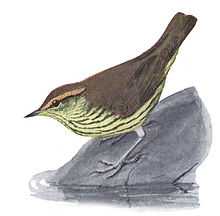Northern Waterthrush
| Northern Waterthrush | |
|---|---|
 | |
| Illustration by Louis Agassiz Fuertes | |
| Conservation status | |
| Scientific classification | |
| Kingdom: | Animalia |
| Phylum: | Chordata |
| Class: | Aves |
| Order: | Passeriformes |
| Family: | Parulidae |
| Genus: | Parkesia |
| Species: | P. noveboracensis |
| Binomial name | |
| Parkesia noveboracensis (Gmelin 1789) | |
| Synonyms | |
|
Seiurus noveboracensis | |
The Northern Waterthrush (Parkesia noveboracensis[2]) is one of the larger New World warblers. It breeds in the northern part of North America in Canada and the northern United States including Alaska. This bird is migratory, wintering in Central America, the West Indies and Florida, as well as in Venezuela, Colombia, and Ecuador. It is a very rare vagrant to other South American countries and to western Europe.
Description
The Northern Waterthrush is a large New World warbler. It has a length of 12–15 cm (4.7–5.9 in), wingspan of 21–24 cm (8.3–9.4 in) and weigh between 13–25 g (0.46–0.88 oz)[3][4] Among standard measurements, the wing chord is 6.8 to 8.2 cm (2.7 to 3.2 in), the tail is 4.5 to 5.7 cm (1.8 to 2.2 in), the bill is 1.1 to 1.2 cm (0.43 to 0.47 in) and the tarsus is 1.9 to 2.3 cm (0.75 to 0.91 in).[5] On the head, the crown is brown with a white supercilium. The bill is pointed and dark. The throat is lightly streaked brown to black with heavier streaking continuing onto the breast and flanks. The back is evenly brown. Sexes are morphologically similar. Young birds have buff, rather than white underparts.
The only species bird watchers confuse with the Northern Waterthrush is the closely related Louisiana Waterthrush (Parkesia motacilla,[2] which has buff flanks, a buff undertail, and bright pink legs. The Louisiana Waterthrush also has a whiter throat with fewer streaks.
Both waterthrush species walk rather than hop, and seem to teeter, since they bob their rear ends as they move along.
Behavior
On the wintering grounds in Puerto Rico, Northern Waterthrushes leave daytime foraging areas and fly up to 2 kilometers to nighttime roosts. The roosts are often located in red mangrove habitats.[6]
Northern Waterthrushes winter in 4 main habitats in Puerto Rico: white mangrove, red mangrove, black mangrove, and scrub. Males, which are larger and migrate earlier in spring, prefer to winter in white mangrove, and are able to maintain or gain weight through the winter. Females winter in the other drier and less food-rich habitats. Waterthrushes wintering red and black mangrove can maintain body weight through the winter but lose weight in scrub.
Reproduction
The breeding habitat of the Northern Waterthrush is wet woodlands near water. It nests in a stump or among tree roots where it lays three to six eggs, cream- or buff-colored, with brown and gray spots. These eggs are laid in a cup nest constructed of leaves, bark strips, and rootlets.
Diet
The Northern Waterthrush is a terrestrial feeder, eating insects, mollusks, and crustaceans found amongst leaf litter.
Vocalization
Its song is a loud swee swee chit chit weedleoo, and its call is a hard chink.
References
- ↑ BirdLife International (2012). "Parkesia noveboracensis". IUCN Red List of Threatened Species. Version 2013.2. International Union for Conservation of Nature. Retrieved 26 November 2013.
- ↑ 2.0 2.1 R. Terry Chesser, Richard C. Banks, F. Keith Barker, Carla Cicero, Jon L. Dunn, Andrew W. Kratter, Kirby J. Lovette, Pamela C. Ramussen, J. V. Remsen, Jr., James D. Rising, Douglas F. Stotz, and Kevin Winker (2010). "Fifty-First Supplement to the American Ornithologists' Union Check-List of North American Birds". The Auk 127 (3): 726–744. doi:10.1525/auk.2010.127.4.966.
- ↑ Eaton, S. W. (1995). "Northern Waterthrush (Parkesia noveboracensis), The Birds of North America Online". Ithaca, NY: Cornell Lab of Ornithology. Retrieved 2008-04-16.
- ↑ FieldGuides: Species Detail. eNature. Retrieved on 2012-08-24.
- ↑ Jon Curson, David Quinn and David Beadle. 1994. New World Warblers: An Identification Guide, ISBN 0-7136-3932-6.
- ↑ Smith, J. A. M., Reitsma, L. R., Rockwood, L. L. & Marra, P. P. (2008). "Roosting behavior of a Neotropical migrant songbird, the northern waterthrush Seiurus noveboracensis, during the non-breeding season". Journal of Avian Biology 39: 460–465.
Further reading
- Cassidy, James (ed.) Book of North American Birds. Reader's Digest: 1990. ISBN 0-89577-351-1.
- Stiles and Skutch, A guide to the birds of Costa Rica ISBN 0-8014-9600-4
External links
| Wikimedia Commons has media related to Seiurus noveboracensis. |
- Smithsonian Migratory Bird Center Waterthrush Research
- Northern Waterthrush Seiurus noveboracensis, USGS
- Northern Waterthrush, Cornell Lab of Ornithology
- Northern Waterthrush videos, Internet Bird Collection
- Northern Waterthrush photo gallery; VIREO Photo-High Res--(Close-up)
